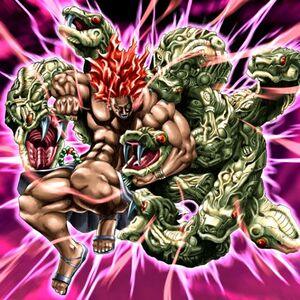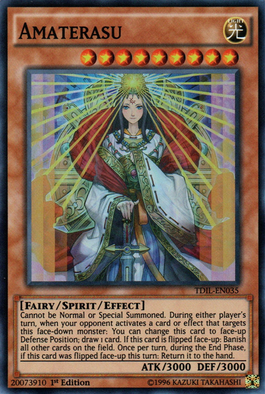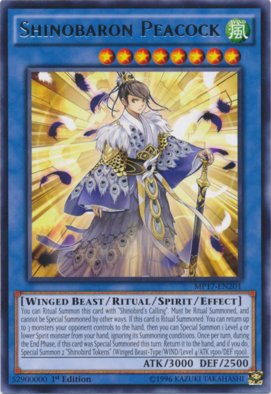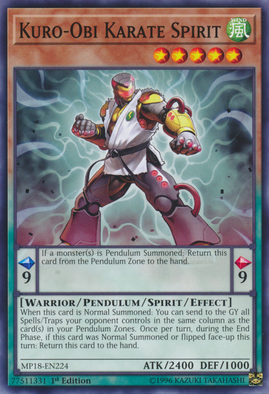Spirit monster
Spirit monsters (スピリットモンスター Supiritto monsutā) are Effect Monsters with the ability "Spirit". With a few exceptions, they cannot be Special Summoned, and have an effect that returns them to their owner's hand during the End Phase of the turn they are Normal Summoned or flipped face-up (or the turn they are Special Summoned in case of Spirit monsters that must be Special Summoned).
The designs of most Spirit monsters are based on icons from Eastern mythology. They all have very similar backgrounds, ostensibly the Spirit World. Their OCG names are in kanji, but the furigana is in katakana which normally would indicate a foreign-language word.
Contents
Design
Spirit monsters are categorized within three groups: Eastern Mythology which are based on various Japanese Youkai and Asian folklore, Duel Terminal of characters in the Duel Terminal story who have passed on thus giving them the "Spirit" ability, and Martial Arts whom are the most recent additions uniquely being Pendulum Monsters and take inspiration from multiple forms of combat. The Shinobird archetype also takes inspiration from the characters played in the Tale of Tanabata.
Eastern Mythology
| Monster | Inspiration |
|---|---|
| Amaterasu | Amaterasu |
| Hino-Kagu-Tsuchi | Kagutsuchi |
| Yamata Dragon | Yamata no Orochi |
| Dark Dust Spirit | Possibly Oni or Shinigami |
| Yamato-no-Kami | Susanoo and the heads of Yamata no Orochi |
| Fenghuang | Fenghuang or "Hou-Ou" |
| Great Long Nose | Red Nose Tengu |
| Susa Soldier | Susanoo and Kusanagi-no-Tsurugi |
| Yaksha | Yaksha |
| Rasetsu | Rakshasa |
| Amano-Iwato | Ama no Iwato |
| Hebo, Lord of the River | Kappa or Hebo |
| Asura Priest | Asura |
| Maharaghi | Shakoukidoguu |
| Fushi No Tori | Phoenix |
| Izanami | Izanami |
| Tsukuyomi | Tsukuyomi |
| Gundari | Kuṇḍali |
| Aratama and Nikitama | Mitama |
| Inaba White Rabbit | Moon Rabbit |
| Otohime | Oto-hime |
| Yata-Garasu | Three-legged crow |
| Kinka-byo | Bakeneko |
| Shinobird Crane | The wearing of Yukata during Tanabata |
| Shinobird Pigeon | Possibly writing of Tanzaku during Tanabata |
| Shinobird Crow | Possibly the Magpies that aid Orihime during Tanabata |
| Shinobaron Peacock | The cowherd Hikoboshi |
| Shinobaroness Peacock | The princess Orihime |
| Yoko-Zuna Sumo Spirit | Sumo |
| Kai-Den Kendo Spirit | Kendo |
| Kuro-Obi Karate Spirit | Karate |
History
Spirit monsters debuted in Mythological Age and received support for the first time in The Duelist Genesis, which was released almost 7 years later. When they are reprinted, it is usually in Structure Decks and Tournament Packs.
There are no archetypes focused on Spirit monsters, but there is one series that does, "Shinobird". The only two archetypes that have Spirit monsters as members are "Ice Barrier" ("Sacred Spirit of the Ice Barrier") and "Gishki" ("Gishki Natalia" and "Emilia"). Both archetypes are WATER-Attribute, and their Spirit monsters don't represent any real life mythological inspirations, instead representing revived spirits of dead characters of their storyline. All of these Spirit monsters were introduced in the Hidden Arsenal series.
Due to the low speed of a dedicated Spirit Deck, as well as their lack of Special Summons and field presence, they never experienced competitive relevance as a Deck theme (although individual members did). There are several competitively noteworthy Spirit monsters, such as "Yata-Garasu", the fundamental part of the Yata-Garasu Lockdown, which has long been Forbidden; "Tsukuyomi", which used to be Forbidden due to its ability to Set Flip monsters again to allow them to activate their effects again, enabling powerful loops; and "Asura Priest", whose ability to attack every opposing monster was unique at the time of its release.
In the anime
In the Yu-Gi-Oh! anime, in episodes 117 and 118, Noah Kaiba used Spirit monsters in his duel against Yami Yugi. According to him, the Spirit monsters were created by Maximillion Pegasus when he was traveling to Eastern Asia and drew inspiration from the religions and mythologies from that region.
In Yu-Gi-Oh! GX and Yu-Gi-Oh! ARC-V, "Asura Priest" and "Dark Dust Spirit" had cameo appearances, in episodes 111 and 21, respectively.
Text
Latest effect text (using PSCT) reads as follow:
Cannot be Special Summoned. [...] Once per turn, during the End Phase, if this card was Normal Summoned or flipped face-up this turn: Return it to the hand.
Playing style
Spirit monsters return to the hand during the End Phase of the turn they were Normal Summoned or flipped face-up, so it is difficult to maintain field presence. This can be worked around with cards like "Spiritual Energy Settle Machine", "Mirror of Yata" and "Izanagi", which allow Spirit monsters to remain on the field in spite of their effects. Also, "Shinobaron Peacock" and "Shinobaroness Peacock" can Special Summon a Level 4 or lower Spirit monster (ignoring the Summoning conditions), which in turn will stay on the field, since it will not have been Normal Summoned. Alternately, some cards provide positive effects whenever a Spirit monster returns to the player's hand: "Spirit's Invitation" forces an opponent's monster to return to the hand whenever a Spirit returns to the hand.
Spirit monsters have a wide variety of effects, including searching for cards (e.g. "Aratama"), allowing an extra Normal Summon (e.g. "Nikitama"), retrieving fallen monsters (e.g. "Izanami"), locking the opponent's attacks (e.g. "Great Long Nose"), and destroying all monsters the opponent controls (e.g. "Dark Dust Spirit"). "Shinobaron Peacock" and "Shinobaroness Peacock" Special Summon a Spirit monster ignoring its Summoning conditions while getting rid of up to 3 opposing cards in the process, and "Shinobird Salvation" destroys an opposing card once per turn when a Spirit monster returns to the hand.
Two of the strongest Spirit monsters, "Hino-Kagu-Tsuchi" and "Yamata Dragon", focus on maintaining significant hand advantage over the opponent, with their effects activating when they inflict battle damage: "Hino-Kagu-Tsuchi" empties the opponent's entire hand before their Draw Phase, while "Yamata Dragon" fills its controller's hand with up to 5 cards. The highest level Spirit monster "Amaterasu, being one of the few monsters that Cannot be Normal Summoned or Set, will Banish every card on the field other than itself making it a devastating game changer if your opponent attacks the Set Amaterasu with no prior warning.
Since Spirit monsters only return to the hand during the End Phase of the turn they are Normal Summoned or flipped face-up, if they fail to return to the hand, such as due to "Dimensionhole" or "Forbidden Chalice", they will not return to the hand in subsequent turns. Summoning Spirits through the effects of Shinobaron Peacock and Shinobaroness Peacock will also enable Spirit monsters to stay on the field, since they were never normal summoned.
There are however monsters like "Dark Dust Spirit" and "Fenghuang" that shine when they can be used repeatedly. Both have the ability to level the field, "Dark Dust Spirit" destroying all monsters, "Fenghuang" destroying all of the opponent's set spell/trap cards. Summoning them repeatedly can be made easier by running cards like "Majiosheldon" and "The Monarchs Stormforth". When running these cards, using "Escalation of the Monarchs" as well is advised, as it allows the player to splash either of these monsters during the opponents turn, repeatedly regaining field control.
Recommended cards
Some of the generic cards that may help a Spirit Deck include:
- "Black Luster Soldier - Envoy of the Beginning": it can be a great beatstick, and can be Summoned by banishing, for example, "Nikitama", "Otohime", "Asura Priest" or "Effect Veiler" and "Yamato-no-Kami", "Aratama", "Great Long Nose" etc, giving the fallen Spirit monsters a last utility.
- "Forbidden Chalice": can be very useful, as it can negate the signature effect of the Spirit monsters and keep them on the field. Use this card after you used their main effect, like after attacking with "Hino-Kagu-Tsuchi" or after destroying a Spell/Trap Card with "Yamato-no-Kami". This card is more valuable when used on high-level monsters, such as "Great Long Nose" or "Yamata Dragon", or Spirits whose effects don't activate upon being Normal Summoned or flipped face-up, such as "Asura Priest" or "Fushi No Tori".
- "D.D. Sprite": this monster can also be used to keep a Spirit monster on the field, and since it is a Tuner monster, it can allow the Deck to perform Synchro Summons. "Ancient Sacred Wyvern" is a useful Synchro Monster that can be Summoned by using one of the Level 6 Spirit monsters; since the Deck frequently has cards that increase the difference between the players' LP ("Spring of Rebirth", "Orb of Yasaka", "Fushi No Tori", etc.), this monster can be used at its maximum potential.
- "Creature Swap"/"Mystic Box": the Spirit monster given to the opponent will return to its owner's hand anyway.
- "The Monarchs Stormforth"/"Soul Exchange": These cards can be used to get rid of an opponent's monster while also Tribute Summoning a Spirit monster.
- "Soul Transition": this card's drawback of not allowing Special Summons during the turn it is used generally is not a problem. It is best used if the monster tributed as cost is "Nikitama", while you control another Spirit monster, preferably "Aratama": in this scenario it is possible to draw 3 cards while also replacing the Tributed "Nikitama" with another copy of it, searched by "Aratama".
Recommended cards
| ||
|---|---|---|
|
Weaknesses
- The main weaknesses of the Spirit Monsters are the fact that they can't stay on the field for long and cannot be Special Summoned (except "Yamato-No-Kami"), which make them having limited swarming capabilities. Due to the difficulty in maintaining field advantage, this Deck is susceptible to direct attacks, so Beatdown and Aggro Decks, like "Six Samurai", "Dark World", "Yosenju", "Karakuri", "Noble Knight", "Spellbook", etc are good against this Deck.
- Stall Decks are a large threat to this Deck, since it is inherently slow due to its lack of swarming and field presence. If "Hino-Kagu-Tsuchi" or "Yamata Dragon" is Summoned but doesn't get a chance to activate its effect, a lot of resources are wasted. As such, "Vengeful Bog Spirit", "Level Limit - Area B", "Threatening Roar", "Gravity Bind", "Chain Energy" and even "Skill Drain" can mean trouble.
- "D.D. Designator" and "Mind Crush" can easily pick a card from the player's hand, since monsters frequently return there.
- "Rivalry of Warlords" and "Gozen Match" can slow this deck down, since Spirit monster Decks typically uses Spirits of different Types and Attributes.
Examples
Effect Spirit Monster ("Amaterasu")
Ritual Spirit Monster ("Shinobaron Peacock")
Pendulum Spirit Monster ("Kuro-Obi Karate Spirit")
Trivia
- "Shinobaron Peacock" and "Shinobaroness Peacock" are the only Ritual Spirit Monsters in the game.
- All Pendulum Spirit Monsters in the game are part of the "Martial Art Spirit" series.
- They are the only Spirit Monsters that can be Special Summoned under any given circumstances, in which case it does not trigger their effect that returns them to the hand.
- The Spirit monster "Yata-Garasu" is infamous for its complete lockdown of the opponent's hand when combined with "Chaos Emperor Dragon - Envoy of the End"; thus, Yata-Garasu has been Forbidden since 2004.
- "Izanagi" is the only non-Spirit Monster that has Spirit World in its background and is the only non-Spirit Monster that directly supports Spirit Monsters.
- "Soul Resurrection" is the only card that has the Spirit World in its background with absolutely no relation to Spirit Monsters.
- The effect that returns Spirit Monsters to the hand, as well as their transparent appearance, may be a reference to them not being able to stay on the physical plane for long.



